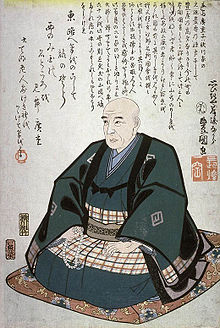Utagawa Hiroshige
| Hiroshige 広重 |
|
|---|---|

Memorial portrait of Hiroshige by Kunisada
|
|
| Born | 1797 Edo, Japan |
| Died | 12 October 1858 Edo, Japan |
| Nationality | Japanese |
| Education | Toyohiro |
| Known for | |
| Notable work | |
| Movement | Utagawa school |
Utagawa Hiroshige (Japanese: 歌川 広重), also Andō Hiroshige (Japanese: 安藤 広重; 1797 – 12 October 1858), was a Japanese ukiyo-e artist, considered the last great master of that tradition.
Hiroshige is best known for his landscapes, such as the series The Fifty-three Stations of the Tōkaidō and The Sixty-nine Stations of the Kiso Kaidō; and for his depictions of birds and flowers. The subjects of his work were atypical of the ukiyo-e genre, whose typical focus was on beautiful women, popular actors, and other scenes of the urban pleasure districts of Japan's Edo period (1603–1868). The popular Thirty-six Views of Mount Fuji series by Hokusai was a strong influence on Hiroshige's choice of subject, though Hiroshige's approach was more poetic and ambient than Hokusai's bolder, more formal prints.
For scholars and collectors, Hiroshige's death marked the beginning of a rapid decline in the ukiyo-e genre, especially in the face of the westernization that followed the Meiji Restoration of 1868. Hiroshige's work came to have a marked influence on Western painting towards the close of the 19th century as a part of the trend in Japonism. Western artists closely studied Hiroshige's compositions, and some, such as van Gogh, painted copies of Hiroshige's prints.
Hiroshige was born in 1797 in the Yayosu Quay section of the Yaesu area in Edo (modern Tokyo). He was of a samurai background, and was the great-grandson of Tanaka Tokuemon, who held a position of power under the Tsugaru clan in the northern province of Mutsu. Hiroshige's grandfather, Mitsuemon, was an archery instructor who worked under the name Sairyūken. Hiroshige's father, Gen'emon, was adopted into the family of Andō Jūemon, whom he succeeded as fire warden for the Yayosu Quay area.
...
Wikipedia
